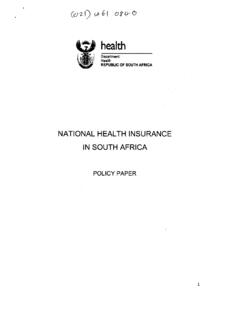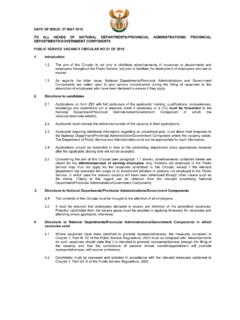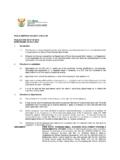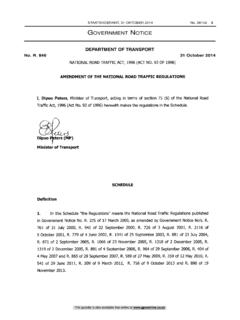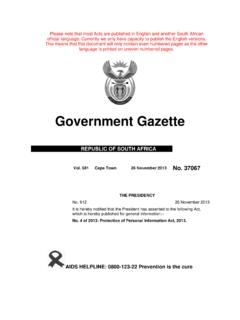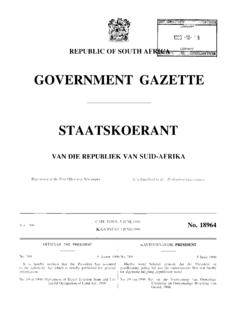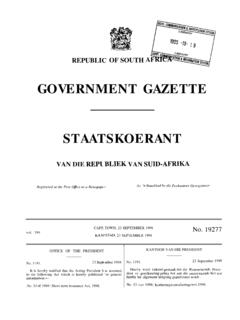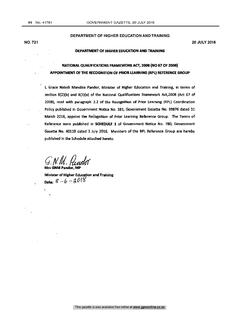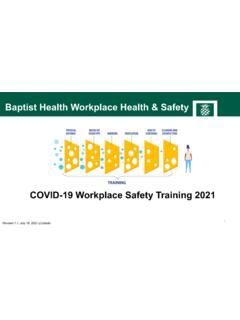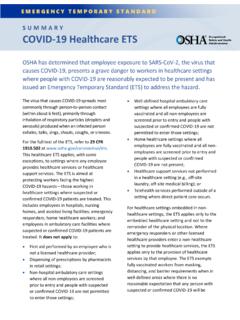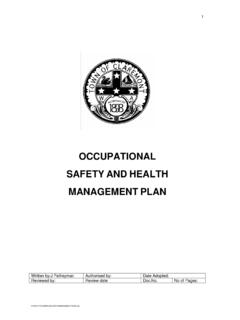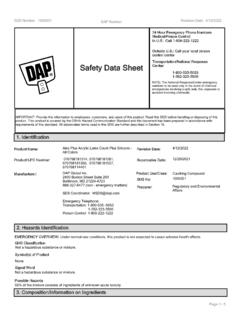Transcription of Occupational health and safety policy for Department of …
1 Occupational health AND safety policy FOR THE NATIONAL Department OF health 2 TA BL E O F CO NT ENTS PAGE 1. INTRODUCTION 3 2. SCOPE 3 3. PURPOSE 3 4. LEGAL FRAMEWORK 4 5. DEF INITI ONS 5-6 6. RESPONSIBILITIES AND OBLIGATIONS 7 7. RESPONSIBILITIES OF THE DIRECTOR GENERAL 8 8. DESIGN AT ION O F HE ALTH AND SAFET Y 10-11 REPRESENTATIVES 9.
2 FUNCTIONS OF THE OCCUPATION AL health AND 11-12 S AFE TY REPRESENTATIVES 10. FACILITIES, TRAINING AND ASSISTANCE TO health 11 AND S AFETY REPRESENTATIVES 11. CO-OPER ATION WITH INSPECTORS BY EMPLOYER AND 12-13 E MPLOYEE 12. OCCUPATION AL health AND safety COMMITTEE 13 13. BUSINESS OF THE health AND safety COMMITEE 13 14. ACTS OR OMISS IONS B Y E MPLOYEES 13 15. CONTINGENCY PLAN 13 16. CO MPLI ANCE 13 17. I MPLE MENT ATI ON 13 18. RECOMMEND ATI ONS 13 3 1.
3 INTRODUCTION Occupational health and safety Act 85 of 1993, requires the employer to provide and maintain as far as reasonable and practical a work environment that is safe and without risk to the health of employees. This means the employer must ensure that the workplace is free of hazardous ergonomics and substances, microorganisms etc, which may cause injury or diseases. Where this is not possible, the employer has to inform the employees of the risks and dangers, and how these may be prevented. The National Department of health is legally obliged and committed to create a healthy and safe working environment for all its employees. 2. SCOPE The provisions of this policy are applicable to all employees and work places of the National Department of health , as well as persons other than employees whilst within the premises of the National Department of health .
4 3. PURPOSE The purpose of this policy is to establish minimum standards and requirements of Occupational health and safety for the National Department of health in order to reduce the risk by: - Identifying hazards and possible risks causing incidents and accidents, Setting standards of practice, procedures and accountability, Measuring performance against standards, Evaluating compliance with standards, Correcting deficiencies, deviations, and set standards of procedures to be followed, Creating and maintaining a healthy and a safe work environment. 4 4. LEG AL FR AM EWORK The directives from which this policy is derived are: i. Constitution of the Republic of South Africa, 1996 (Act No.)
5 108 of 1996) ii. Occupational health and safety Act 85 of 1993, as amended and regulated issues in terms of section 43 of the Act iii. Compensation for Occupational Injuries and Diseases Act 130 of 1993, as amended iv. Basic Conditions for Employment Act 75 of 1997, as amended v. Labour Relations Act 66 of 1995, as amended vi. Employment Equity Act 55 of 1998, as amended vii. Disaster Management Act 57 of 2000 as amended viii. Public Service Act 103 0f 1994 as amended ix. Fire brigade Act 99 of 1997 as amended x. Hazardous Substance Act 15 of 1973 as amended xi. General Administration Regulations 2003 xii. PSCBC Resolution 2 of 1999, as amended xiii. National Water Act 36 of 1998 xi v. National Building Regulation act 103 of 1977 xv. National Environmental Management Act 107 of 1998 xvi. Environmental Conversation act 73 of 1989 xvii. Road Transportation Act 74 of 1979 as amended xviii. Tobacco control act 83 of 1993 as amended xix. Public Service Regulations, 2001, as amended xx.
6 Access to Public Premises and Vehicles Act 53 of 1985 xxi. National health Act 61 of 2003 5 5. DEFINITIONS Act means the Occupational health and safety Act 85 of 1993. Accident means any accident arising out of and in the course of an employee s employment and resulting in a personal injury, illness or death of the employee. Chief f ire coordinator means contingency officer w ho is responsible for t he coordination of fire team in the designated areas. Cont ingenc y Plan means any action that is to be activated during any emergency situation in order to prevent and/or combat or counteract the effects and results of an emergency situation where life or property is threatened. Cont ingenc y Officers for the purpose of this policy means an Occupational health and safety representative.
7 Compensation Commissio ner means the Compensation Commissioner appointed under Section 2 of the Compensation for Occupational Injuries and Diseases Act 1993 Department means National Department of health . Danger means anything that may cause injury or damage to persons or property. Employer means the Director-General of the Department of health or the official to whom the responsibility for compliance with the Act has been delegated. Employee means any person who is employed by or works for the employer and who receives or is entitled to receive any remuneration or who works under the direction or supervision of the employer. Hazard means any source of/ or exposure to danger. Healthy means free from illness or injury attributable to Occupational causes. health and safety standard means any standard irrespective of whether or not; it has the force of law, which if applied for the purpose of this policy , will in the opinion of the Director-General promote the attainment of objectives of this policy .
8 Inspector means an Occupational health and safety Inspector of the Department of Labour. Occupational health includes Occupational hygiene, Occupational medicine and biological monitoring. 6 Occupational health and safety Representative (OHSR) means authorized person designated to perform health and safety duties in the National Department of health . Occupational health and safety Committee means a committee established under section 19 of the Occupational health and safety Act 85 of 1993 Occupational Hyg iene means anticipation, recognition evaluation and control of conditions arising in or from the workplace, which may cause illness or adverse health effects to persons. Occupational medicine means the prevention, diagnosis and treatment of illness, injury and adverse health effects associated with a particular type of work.
9 Premises include any building, vehicle or aircraft owned by the National Department of health . Proper use means use of any item with reasonable care, and with due regard for any information, instruction or advice supplied by the designer, manufacturer, importer seller or supplier. Risk means the probability that injury or damage will occur. Safe means free from any hazard. Workplace means any premises or place where an official of the National Department of health performs work in the course of her/his employment. 7 6. RESPONSIBI LITI ES AND OB LIGATIONS It is the responsibility of both the employer as well as all employees to ensure a safe and healthy working environment in the premises of the National Department of health .
10 GENERAL DUTIES OF THE NDoH AS AN EMPLOYER TO THE EMPLOYEES The Department shall provide and maintain all equipment that is necessary to perform work and all systems according to which work must be done, in a condition that will not affect the health and safety of employees. Protective equipment should be provided where it is required to mitigate risks and hazards. To ensure that these duties are complied with, the employer must: i. take measures to protect employee s health and safety against hazards that may result from the production, processing, use, handling, storage or transportation of articles/substances anything that employees come into contact with at work. ii. ensure that contingency officers are equipped with the first aid kit that would be accessible to all employees in case of emergency. iii. identify potential hazards which may be present while work is being done, something is being produced, processed, used, stored or transported.
